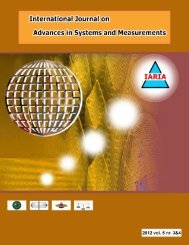Fault Tolerance Framework using Model-Based - IARIA Journals
Fault Tolerance Framework using Model-Based - IARIA Journals
Fault Tolerance Framework using Model-Based - IARIA Journals
Create successful ePaper yourself
Turn your PDF publications into a flip-book with our unique Google optimized e-Paper software.
International Journal on Advances in Security, vol 4 no 1 & 2, year 2011, http://www.iariajournals.org/security/<br />
and a prototype is developed and shown in [6].<br />
Figure 3. BPMN element description.<br />
• Business rule models; a business rule is a statement<br />
that defines those aspects of business processes that are<br />
impossible to gather or express in the model [20]. In<br />
fact, by separating business logic from business design,<br />
if the business process logic changes then, only the<br />
business rules must be changed but not the business<br />
process. Business rules can be formalized as ”if-then”<br />
statements in a selected Business Rule Management<br />
Systems (BRMS), by <strong>using</strong> natural language or formal<br />
methods. BRMS is a software system employed<br />
to define, deploy, execute, monitor, and maintain the<br />
variety and complexity of decision logic that is used<br />
by operational systems within an organization. In our<br />
proposition, business rules act as an ”oracle”. Thus,<br />
they indicate the correctness of outputs of the business<br />
processes.<br />
• Constraint models are necessary in the model-based<br />
diagnosis stage where Constraint Satisfaction Problems<br />
(CSP) are used. In our proposition, constraint models<br />
are employed to describe behaviour activities gathered<br />
within business processes. Constraint models can be<br />
constructed off-line or on-the-fly. Process constraint<br />
models can be built online since logs captured where<br />
information of inputs, outputs and service constraint<br />
model can be given. Both Diagnosis and CSPs will be<br />
described in Section III-C.<br />
Business process validation analysis methods are focused<br />
on discovering whether the designed business processes can<br />
be automatically enacted as expected. Through this analysis,<br />
any possible constraint violations should be detected. In<br />
various studies, process models have been analyzed in order<br />
to prevent structural faults in the form of : Petri Nets<br />
[21]; a set of graph reduction rules to identify structural<br />
conflicts in process models [22]; and an improved version<br />
of the latter method [23]. However, in a earlier work [6]<br />
a business process validation has been studied, and an<br />
automatic mechanism to fault structural diagnosis has been<br />
integrated in a editor of BPMN diagrams.<br />
B. Application Layer<br />
In this layer, various technologies which are used to implement<br />
and deploy models are introduced. Business Process<br />
Execution Language (BPEL) is a de facto standard language<br />
for the implementation of service-based business processes.<br />
The main advantages in <strong>using</strong> BPEL as an implementation<br />
language are:<br />
• BPEL supports all necessary elements in the implementation<br />
of sophisticated business processes, such as<br />
those in BPMN, and provides a sufficient number of<br />
mechanisms to implement fault tolerant mechanisms<br />
[24].<br />
• BPEL processes are specific implementations of business<br />
processes for service-oriented environments, as<br />
suggested in [4].<br />
• The majority of the distinguished commercial and noncommercial<br />
tools support service-oriented architectures<br />
and BPEL processes as shown in Table I.<br />
Table I<br />
COMPARATIVE OF BPM TOOLS.<br />
Although BPMN is a standard notation for the design<br />
of process models, it could automatically be translated into<br />
BPEL [19][25][26], and most commercial BPMSs support<br />
BPMN and BPEL processes. Therefore, BPEL processes<br />
represent the best candidate and will be used in our proposal.<br />
A BPEL environment is necessary for the implementation<br />
and deployment operational business process. In this proposal,<br />
GlassFishESB have been integrated in our framework.<br />
NetBeans provides an environment in order to develop BPEL<br />
2011, © Copyright by authors, Published under agreement with <strong>IARIA</strong> - www.iaria.org<br />
14







